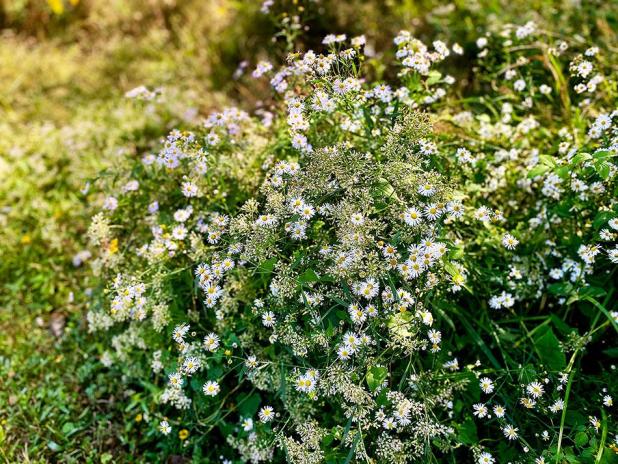
False aster (Boltonia asteroids) is a perennial native wildflower that blooms each fall.
—LSU AgCenter/Heather Kirk-Ballard
Get It Growing: Collecting, conserving native wildflower seeds
The native wildflowers are just gorgeous right now. If you haven’t noticed all the beautiful yellow, purple and white flowers along the roadsides, in ditches and in natural areas, you are sure to notice them soon.
Among the many native species blooming this fall are false aster (Boltonia asteroids), swamp sunflower (Helianthus angustifolius), goldenrod (Solidago spp.), blue mistflower (Conoclinium coelestinum) and late boneset (Eupatorium serotinum). They dot the fall landscape like a painting of a serene meadow of flowers.
All of these species are native to the southeastern United States, and although they can be found spread throughout the natural landscape, many of these plants cannot be easily found in retail garden centers. This is in part because of the demand for more popular ornamental plants. However, there is a positive movement for more native plants from consumers.
Native wildflowers offer numerous benefits to the environment, ecosystems and our communities. Some of these benefits include attractive flowers and foliage, biodiversity, climate resilience including drought and high temperatures, disease resistance and low maintenance.
Native wildflowers provide essential habitat and food sources for local wildlife, including pollinators like bees, butterflies and birds. This promotes biodiversity by sustaining a variety of species in an ecosystem.
Wildflowers also help improve water quality and soil health in the areas that they grow.
Incorporating native wildflowers into landscaping and conservation efforts is an effective way to promote ecological health, preserve local biodiversity and create more sustainable and beautiful environments.
Saving wildflower seeds is a great way to grow your own wildflowers. By preserving and planting native plant species, you can support biodiversity in your community. Here are some tips on collecting and saving wildflower seeds.
First, gather all of the supplies you will need. I suggest small paper bags or envelopes, hand pruners or scissors, labels and permanent markers.
Identify the wildflowers from which you want to collect seeds. It’s important to make sure you’re collecting seeds from native plants and not invasive species. You can use the U.S. Department of Agriculture plant identification website or download apps to help you identify the plant. You also can send a photo to your local LSU AgCenter agent.
Cut the seed heads from the plant using garden shears or scissors. Make sure to leave some seeds behind for natural propagation. Place the seed heads in the paper bags or envelopes. It’s essential to store the seeds in paper because it allows for air circulation and prevents mold growth. Label each bag or envelope with the name of the plant, collection date and where you collected the seeds.
Next, dry the seeds by placing the bags or envelopes in a cool, dry, well-ventilated area. Allow the seeds to air dry for about two weeks. This will help prevent mold and ensure the seeds are fully mature.
Finally, clean the seeds once they have dried. Gently shake or rub the seed heads to release the seeds into the bag or envelope. Remove any plant debris, chaff or non-seed material. You can do this by gently blowing on the seeds or using a fine-mesh strainer to separate the seeds from the chaff.
Now you are ready to store your seeds in a cool, dry place in airtight containers such as glass jars or plastic bags. Be sure to label the containers with the plant’s name and collection date. It’s a good idea to store the seeds in the refrigerator to maintain their viability.
You can also sow the seeds directly instead of storing them if the conditions are right. You can start seeds indoors at any time but should wait until the danger of the last frost to plant outdoors. When you’re ready to sow the seeds, follow the specific planting instructions for each wildflower species. Some seeds may require stratification (a period of cold treatment) while others can be directly sown in your garden.
In the coming years, you can continue to collect seeds or let Mother Nature disperse them naturally. Share seeds and plants with friends.
By saving and planting wildflower seeds, you can contribute to the conservation of native plants, support local pollinators and create a beautiful, biodiverse garden. Many native wildflowers are endangered or threatened due to habitat loss. By planting and preserving native wildflowers, we can aid in the conservation and restoration of these species and their ecosystems.
